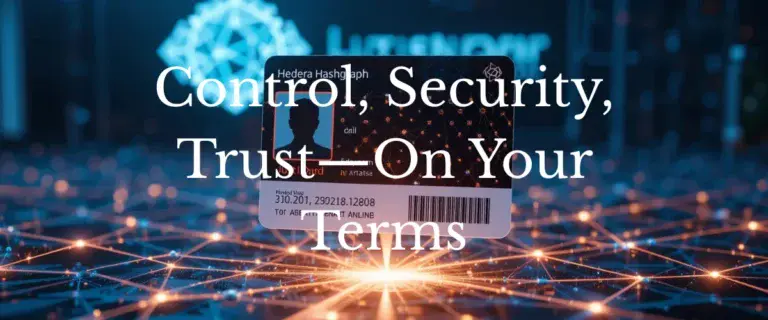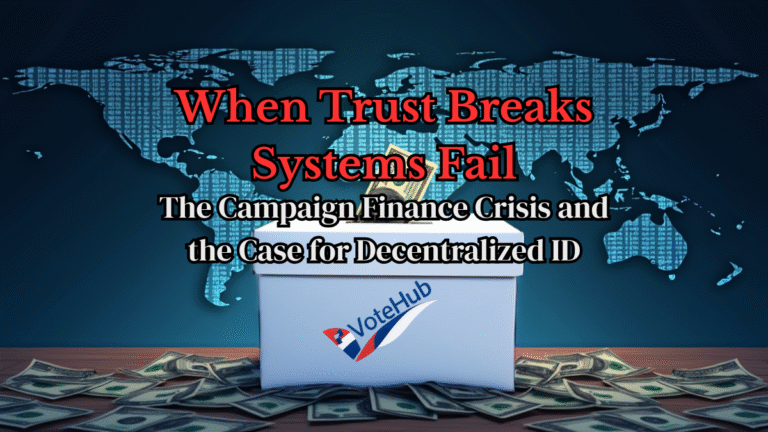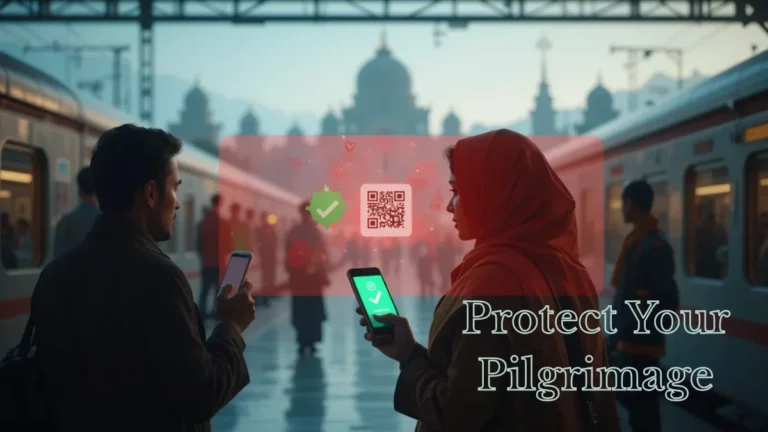Reclaim Control Over Your Digital Identity and Data Privacy
Learn Why Web3 Has Rescued You
- The pitfalls of Web2: Data exploitation and lack of control.
- How Web3 transforms identity management through decentralization.
- The power of Self-Sovereign Identity (SSI) in protecting your personal information.
- The role of Decentralized Identifiers (DIDs) in enhancing security.
- Practical steps to transition to a more secure digital lifestyle.
Your Digital Identity is Waiting
- Unlock Your Freedom: Discover how taking control of your digital identity can liberate you from corporate surveillance.
- Transform Your Online Experience: Embrace a new era of privacy and security tailored just for you.
- Stay One Step Ahead: Learn insider strategies to outsmart cyber threats and keep your data safe.
- Own Your Identity: Find out how Self-Sovereign Identity (SSI) puts you in the driver’s seat of your online persona.
- Future-Proof Yourself: Equip yourself with cutting-edge knowledge to thrive in the evolving digital landscape.
- Take Action Now: Don’t wait! Start implementing powerful strategies today to safeguard your digital life.
Explore Secure Digital Wallets
Consider looking for popular digital wallet services that emphasize security and user control.
Join the Web3 Revolution! Share this post and empower your network to reclaim their digital identities today.
Decentralized Identity is Your Digital Passport to Web3
The digital revolution is upon us, and it’s time you ditch the outdated trappings of Web2. Enter Web3 and Decentralized Identity (DID) – your ticket to reclaiming control, enhancing privacy, and securing your digital self from centralized vulnerabilities.
The Essence of Decentralized Identity
Imagine a world where you hold the keys to your digital identity. That’s the promise of DID.
So what does Web3 look like and will I be convinced?
These are the layers of protection and enhancements of Web3:
- Your Wallet: A digital vault for your cryptographic keys
-
- Think of your wallet as the foundational layer where you store your cryptographic keys, essential for accessing and managing your digital identity.
- This wallet not only holds keys for authentication but also simplifies interaction with other layers by providing a secure access point.
- Self-Sovereign Identity (SSI): You decide what to share and when
-
- SSI empowers you to control your identity, allowing you to decide what information to share and with whom, at any given time.
- The wallet facilitates SSI by providing the cryptographic keys needed to create and manage your identity, ensuring you maintain control over your personal data.
- Decentralized Identifiers (DIDs): Your unique digital passport number
-
- DIDs act like your unique digital passport number, enabling you to establish a verifiable identity without reliance on a central authority.
- Your wallet generates and manages DIDs, linking them to your SSI. This allows you to present your identity in various contexts while retaining control.
- Verifiable Credentials (VCs): Digital attestations about you, cryptographically verified
-
- VCs are digital attestations about you, verified through cryptographic means. They serve as proof of certain attributes, like age or educational qualifications. This is the new digital you, encrypted.
- Your wallet allows you to store and manage these credentials securely. When sharing a VC, your SSI framework ensures that you can present it selectively, maintaining your privacy.
- Decentralized Storage: Your data, securely stored and accessible only with your permission
-
- An encrypted Fort Knox for your data.
- The storage solution works in tandem with your wallet and DIDs. Your wallet serves as the key to accessing this data, while SSI rules dictate who can access what information and under what circumstances.
This is Web3.
Web3 aims to address vulnerabilities through decentralization, encryption, and user control. The heart of this effort is Self-Sovereign Identity (SSI).
Let’s Dive Into Self-Sovereign Identity (SSI)
The self-sovereign Identity (SSI) and decentralized system philosophy will enhance user control and security. These are the key concepts to understand.
1. Data Ownership vs. Storage
- User Control is Paramount – In Web 2 we gave everyone our data and they profited off of us. Web3 turns the username-password model inside out. No longer will we pass out our information, create a username-password combo, and pray they protect our data. I will keep my information secure, private, and encrypted. When you want something from me, I will give you just what you want when you ask nicely. No one is allowed to keep my information, except me.
2. Data Fragmentation
- Reduced Risk – I will keep my information encased in a blockchain vault. As a visual learner, when I hear the term, blockchain, my mental vision is a cylindrical strand of the network fiber with a beginning and an end connected to billions of other strands. Within that one strand are various nodes (computers), which could be large or small computers, but millions of these are interconnected. Blockchain technology farms my data out to various nodes within the chain. Only me and my DID Key know where all of the pieces are. This makes it extremely difficult for hackers to access large volumes of personal data at once, reducing the risk of a single point of failure.
3. Encryption and Privacy
- Secure Access – Data on the blockchain is heavily encrypted. Even if it exists on a public ledger, it remains inaccessible without the appropriate cryptographic keys. This means that unauthorized parties cannot read your data, regardless of its location.
4. Permission-Based Sharing
- Selective Disclosure – You decide what data to share when using SSI. For example, if a service requests your age for verification, you can provide a verifiable credential (VC) that confirms your age without revealing other personal information. If the restriction is based on age, 21 to purchase alcohol, showing your driver’s license is overkill. Doing so reveals your name, address, and other sensitive data. A simple tap of your wallet containing SSI information will prove you are at least 21, and nothing more.
5. Transparency and Auditability
- Public Verification: The transparency of blockchain allows for auditing and verification. The only thing stored on the blockchain ledger is the transaction information. Not your data. You paid Xyz Barber $25 for your haircut on 12/12/24. This is stored and is visible to auditors. The auditors can not see that your account ending in 5432 was used or that you have $23,123 in that account. This limited visibility deters bad actors. They cannot easily access personal information or account details.
6. Community Governance
- Decentralized Decision-Making: Decentralized systems have governance mechanisms that let users participate in decisions about data management and security practices as technology evolves. Web3 is just the next step. Web20 will exist well into the future. For smoother transitions, each blockchain system has its own form of decentralized governance. The most common form of governance is DAO. There are other forms, and I will discuss this in another post.
-
- Decentralized Autonomous Organizations (DAOs) – DAOs are organizations represented by rules encoded as smart contracts on the blockchain. Members hold governance tokens that grant voting rights on proposals related to data management, funding, and changes in protocol. Decisions are made collectively, reducing the concentration of power.
7. Resilience Against Attacks
- Diverse Nodes: Decentralized networks rely on a multitude of independent nodes, making it harder for attackers to compromise the entire system. Even if one node is hacked, the integrity of the overall network will remain intact.
While it’s true that your data is stored on the blockchain, the key difference lies in the control, access, and security mechanisms that empower you as the user. Web3 systems are designed to enhance user sovereignty and reduce the risks associated with data breaches common in Web2. By maintaining ownership, implementing encryption, and allowing selective sharing, Web3 aims to create a more secure and user-centric environment for managing personal data. Your trust in these systems is crucial, and ongoing improvements in technology and governance are focused on ensuring that this trust is well-placed.
The Power of Decentralization
DID leverages blockchain technology. The file system that blockchains use is The InterPlanetary File System (IPFS), the brainchild of Juan Benet. The InterPlanetary File System (IPFS) is a peer-to-peer distributed file system that aims to connect all computing devices with the same system of files.
IPFS Key Features
- Content Addressing – Instead of using traditional URLs that point to a location, IPFS uses a Content Identifier (CID) that points to the content itself. This means that files can be retrieved based on their content rather than their location.
- Decentralization – Files are distributed across a network of nodes, reducing reliance on a single server.
- Versioning – IPFS supports versioning of files, allowing users to access previous versions of content easily.
- Efficient Bandwidth Usage – IPFS optimizes data transfer by utilizing a distributed hash table (DHT) to find and retrieve content from the closest available node.
Smart Contracts
Smart contracts are like digital agreements that automatically do what they’re supposed to when certain conditions are met. For example, if you agree to pay someone after they deliver a product, the payment happens automatically as soon as the delivery is confirmed. The details of these agreements are written into the smart contract itself, making it clear what each party needs to do. These contracts are stored on the blockchain.
One of the great things about smart contracts is that they can work without needing a middleman, like a bank or a lawyer, to oversee things. This means that once you set the terms, everything happens automatically, saving time and reducing costs. They offer a straightforward way to handle transactions, ensuring that everyone knows what to expect without having to trust the other party completely.
Decentralized Identity, Web3, and You
Decentralized Identity (DID) represents a transformative shift from traditional digital identity systems to a more secure and user-controlled model in the Web3 era. With DID, individuals hold the keys to their digital identities, allowing them to manage what information they share and with whom. This new framework includes personal digital wallets that store cryptographic keys, enabling self-sovereign identities (SSI) where users maintain control over their personal data. Decentralized Identifiers (DIDs) function like unique digital passport numbers, allowing users to establish verifiable identities without relying on central authorities. Verifiable Credentials (VCs) serve as cryptographically verified attestations about users, ensuring privacy while sharing only necessary information.
Web3 enhances security through decentralization, encryption, and permission-based sharing, reducing the risks of data breaches common in Web2 environments. Unlike traditional models that require central repositories, Web3 distributes identity data across a network, ensuring no single entity controls personal information. Key features of this decentralized approach include transparent data access, community governance through Decentralized Autonomous Organizations (DAOs), and resilience against attacks due to the diversity of nodes in the network. Together with technologies like the InterPlanetary File System (IPFS) for decentralized storage and smart contracts for automated transactions, Web3 empowers users to reclaim control over their digital identities while enhancing privacy and security in online interactions.
Spread the Word for Web3 Rescued
The future of the internet is here, and it’s decentralized. Web3 holds the promise of a more open, transparent, and user-controlled web. Now that you understand the building blocks, it’s time to help others discover the power of Web3.
Join the movement towards a decentralized future.
Share this post and help others discover the power of Web3 and Web3 Rescued!
Let’s work together to build a decentralized future.








